Abstract
Although most studies have concentrated on fatal residential fire injuries, which are a leading cause of fatal injuries in the United States, few investigators have examined in detail nonfatal injuries as a consequence of residential fires. This population-based study used the Washington State Fire Incident Reporting System to assess the incidence and descriptive epidemiology of fatal and nonfatal burns or respiratory tract damage resulting from unintentional residential fires. For the 2-year period 1984-85 in King County, WA, the mortality rate due to injury in a residential fire was 0.7 per 100,000 per year, and the incidence of nonfatal injuries was 5.6 per 100,000 per year. Of 17 fatalities, 59 percent of the deaths occurred at the scene of the fire. Of 128 persons with nonfatal injuries, 19 percent were hospitalized; although the 55 percent seen as outpatients and the 26 percent treated by the fire department or paramedics at the fire scene usually had minor injuries, they would not have been captured if only traditional data sources had been employed. Those injured averaged 2.8 days of restricted activity, but the range was from less than 1 day to 1 year. Injuries were more common in the households with a low socioeconomic status and among nonwhites, especially American Indians. Variation in incidence by age, sex, and source of ignition for deaths and nonfatal injuries suggests appropriate targets for future fire injury prevention programs.
Full text
PDF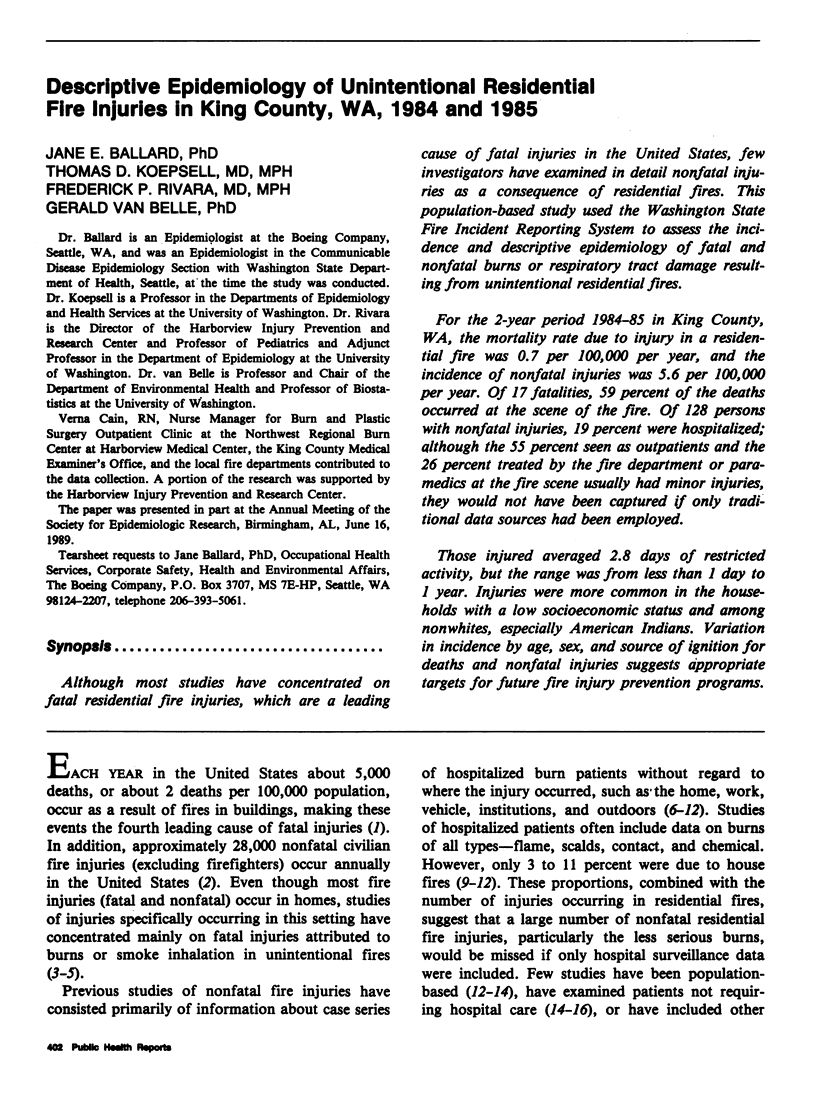


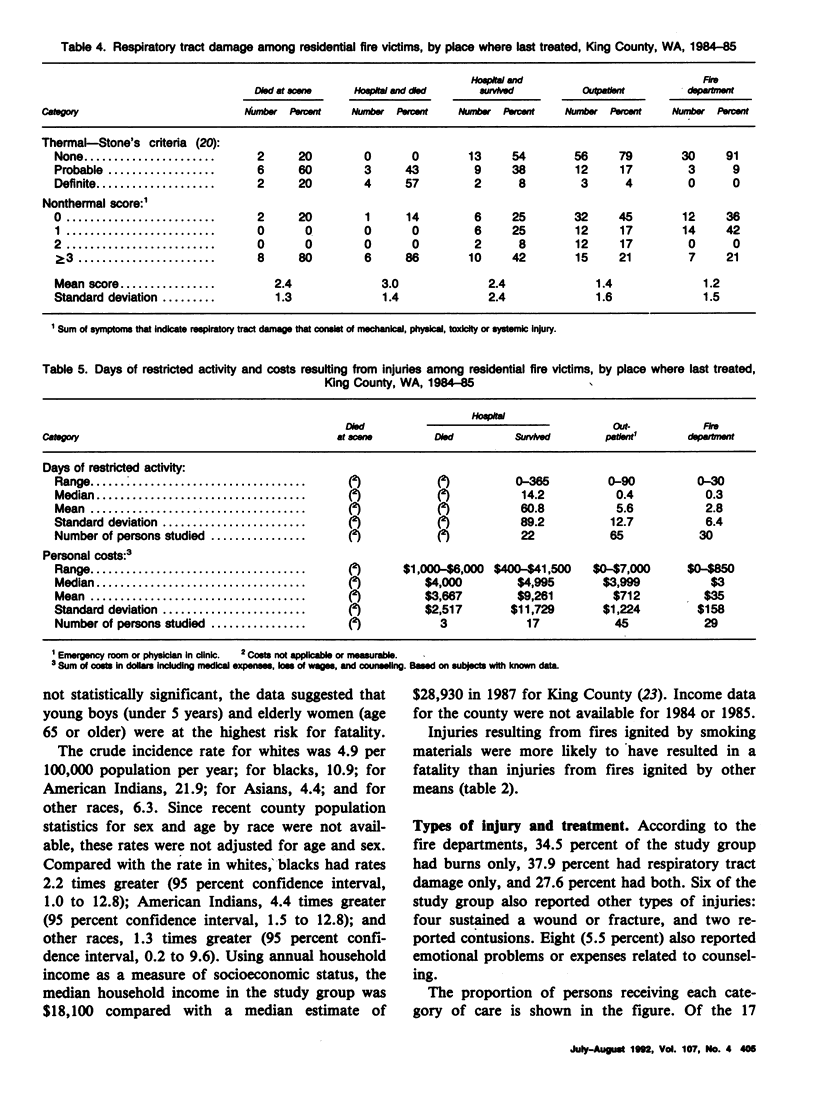
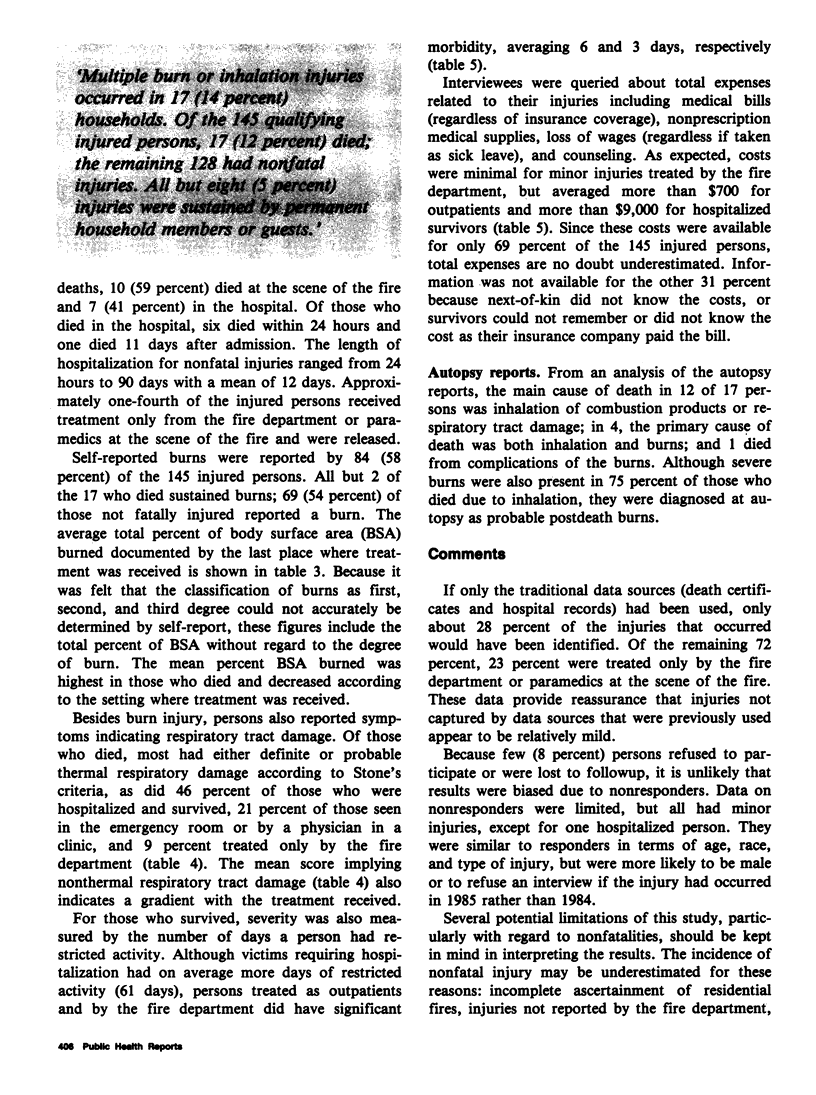
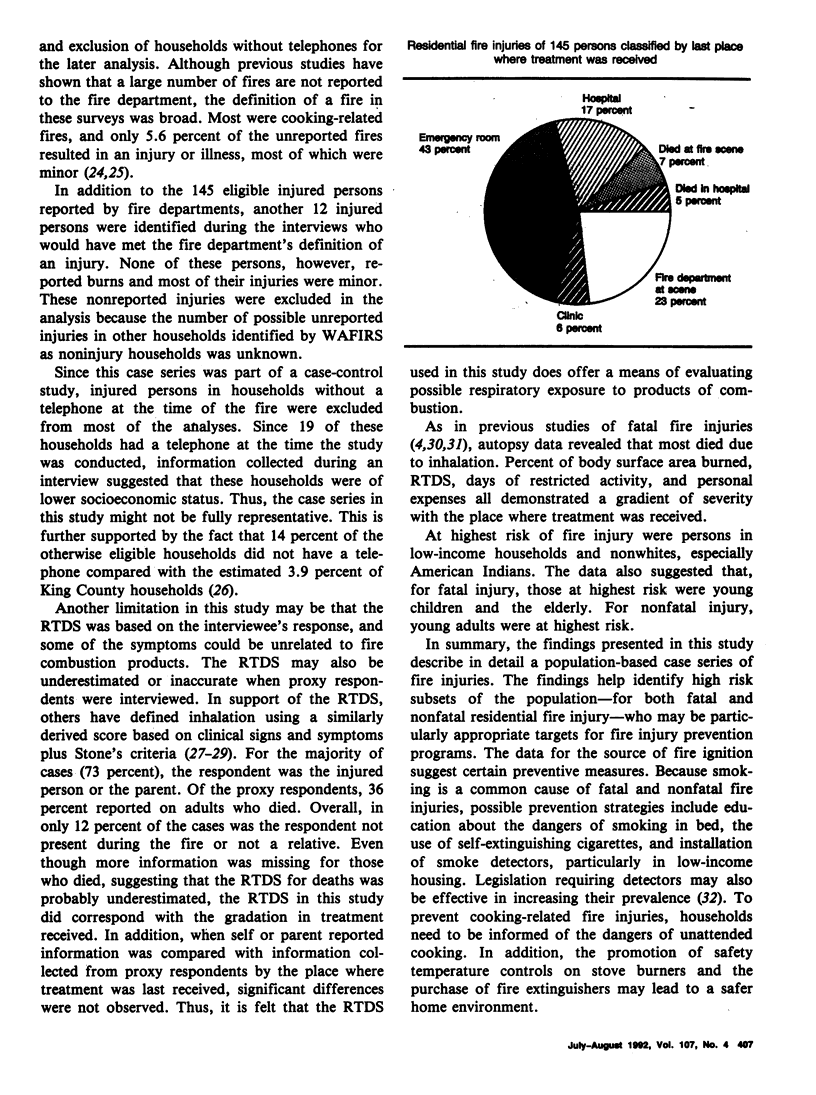
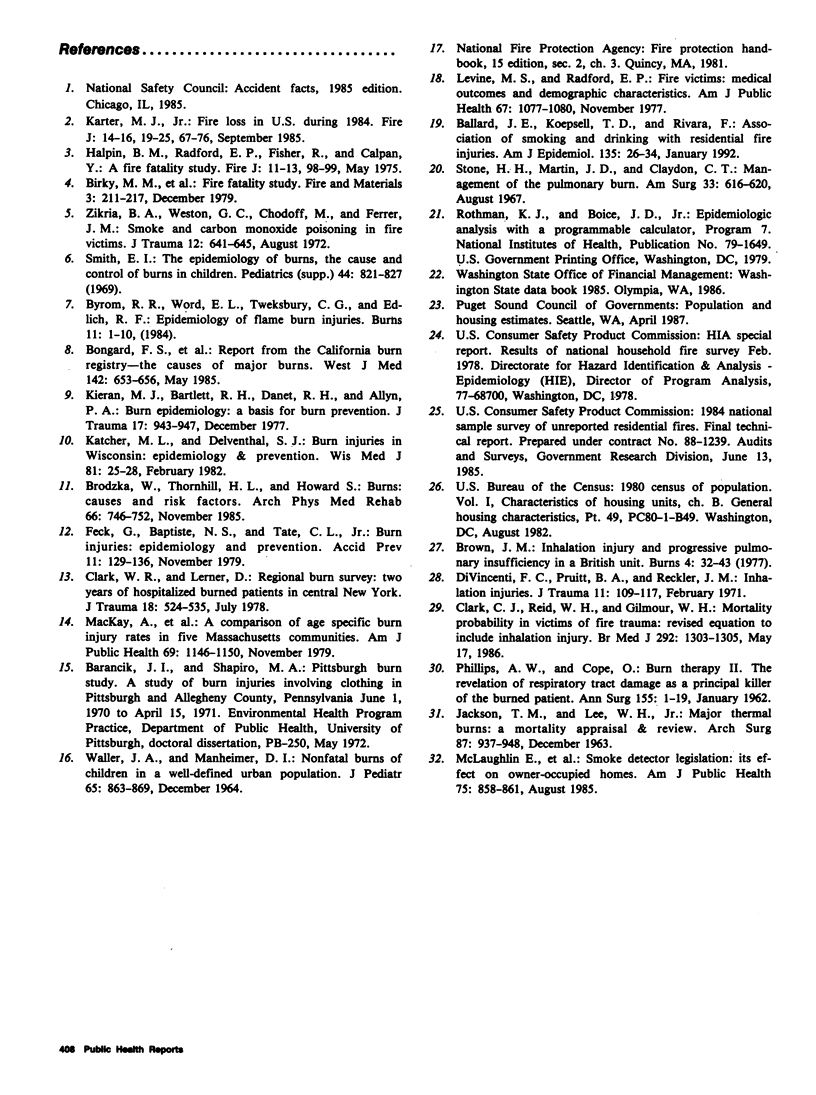
Selected References
These references are in PubMed. This may not be the complete list of references from this article.
- Ballard J. E., Koepsell T. D., Rivara F. Association of smoking and alcohol drinking with residential fire injuries. Am J Epidemiol. 1992 Jan 1;135(1):26–34. doi: 10.1093/oxfordjournals.aje.a116198. [DOI] [PubMed] [Google Scholar]
- Bongard F. S., Ostrow L. B., Sacks S. T., McGuire A., Trunkey D. D. Report from the California Burn Registry--the causes of major burns. West J Med. 1985 May;142(5):653–656. [PMC free article] [PubMed] [Google Scholar]
- Brodzka W., Thornhill H. L., Howard S. Burns: causes and risk factors. Arch Phys Med Rehabil. 1985 Nov;66(11):746–752. [PubMed] [Google Scholar]
- Byrom R. R., Word E. L., Tewksbury C. G., Edlich R. F. Epidemiology of flame burn injuries. Burns Incl Therm Inj. 1984 Oct;11(1):1–10. doi: 10.1016/0305-4179(84)90154-2. [DOI] [PubMed] [Google Scholar]
- Clark C. J., Reid W. H., Gilmour W. H., Campbell D. Mortality probability in victims of fire trauma: revised equation to include inhalation injury. Br Med J (Clin Res Ed) 1986 May 17;292(6531):1303–1305. doi: 10.1136/bmj.292.6531.1303. [DOI] [PMC free article] [PubMed] [Google Scholar]
- Clark W. R., Lerner D. Regional burn survey: two years of hospitalized burned patients in central New York. J Trauma. 1978 Jul;18(7):524–532. [PubMed] [Google Scholar]
- DiVincenti F. C., Pruitt B. A., Jr, Reckler J. M. Inhalation injuries. J Trauma. 1971 Feb;11(2):109–117. doi: 10.1097/00005373-197102000-00002. [DOI] [PubMed] [Google Scholar]
- JACKSON T. M., LEE W. H., Jr MAJOR THERMAL BURNS. A MORTALITY APPRAISAL AND REVIEW. Arch Surg. 1963 Dec;87:937–948. doi: 10.1001/archsurg.1963.01310180053010. [DOI] [PubMed] [Google Scholar]
- Jay K. M., Bartlett R. H., Danet R., Allyn P. A. Burn epidemiology: a basis for burn prevention. J Trauma. 1977 Dec;17(12):943–947. [PubMed] [Google Scholar]
- Katcher M. L., Delventhal S. J. Burn injuries in Wisconsin: epidemiology and prevention. Wis Med J. 1982 Feb;81(2):25–28. [PubMed] [Google Scholar]
- Levine M. S., Radford E. P. Fire victims: medical outcomes and demographic characteristics. Am J Public Health. 1977 Nov;67(11):1077–1080. doi: 10.2105/ajph.67.11.1077. [DOI] [PMC free article] [PubMed] [Google Scholar]
- MacKay A., Halpern J., McLoughlin E., Locke J., Crawford J. D. A comparison of age-specific burn injury rates in five Massachusetts communities. Am J Public Health. 1979 Nov;69(11):1146–1150. doi: 10.2105/ajph.69.11.1146. [DOI] [PMC free article] [PubMed] [Google Scholar]
- PHILLIPS A. W., COPE O. Burn therapy. II. The revelation of respiratory tract damage as a principal killer of the burned patient. Ann Surg. 1962 Jan;155:1–19. doi: 10.1097/00000658-196201000-00001. [DOI] [PMC free article] [PubMed] [Google Scholar]
- Stone H. H., Martin J. D., Jr, Claydon C. T. Management of the pulmonary burn. Am Surg. 1967 Aug;33(8):616–620. [PubMed] [Google Scholar]
- WALLER J. A., MANHEIMER D. I. NONFATAL BURNS OF CHILDREN IN A WELL-DEFINED URBAN POPULATION. J Pediatr. 1964 Dec;65:863–869. doi: 10.1016/s0022-3476(64)80010-x. [DOI] [PubMed] [Google Scholar]
- Zikria B. A., Weston G. C., Chodoff M., Ferrer J. M. Smoke and carbon monoxide poisoning in fire victims. J Trauma. 1972 Aug;12(8):641–645. doi: 10.1097/00005373-197208000-00001. [DOI] [PubMed] [Google Scholar]


